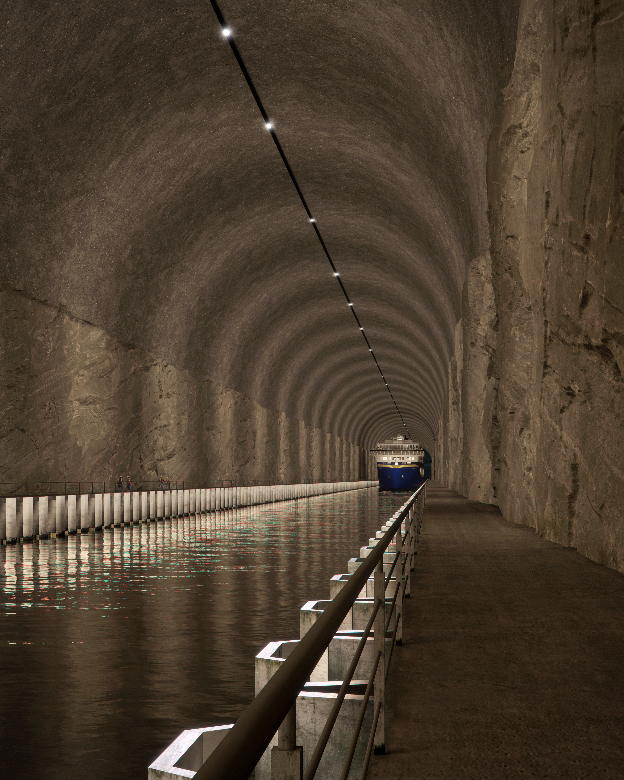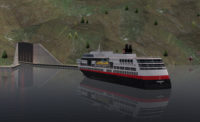Contracts
Norway to Seek Bids for World's First Large Ship Tunnel

The tunnel leads to calm water outside the eastern portal.
Rendering courtesy Norwegian Coastal Administration
Folklore has it that even the fierce Vikings were daunted by the treacherous Shadhavet Sea off Norway's west coast. Now, 150 years after being conceived, a plan for a safer route through that same sea is coming to fruition as the Norwegian Coastal Administration prepares to procure the world’s first large ship tunnel.
This fall, the agency plans to invite turnkey contract bids for the 1.7-kilometer-long Stad ship tunnel, big enough to transport the cruise ships to travel up and down the coast. The tunnel will cut through the stem of the roughly 30-km-long Stad peninsula, which now pushes ships out into the perilous sea.
Calling for around 3 million cu m of excavation, the tunnel will be 50 m tall and 36 m wide. Drill and blast techniques will excavate the 1,661-sq-m tunnel face.
But before around five years' construction can start, possibly in 2025, the agency must demonstrate that it has managed the sometimes errant cost estimates within its allocated budget of around $390 million at 2021 prices.
In Norway, a government project budget amounts to a sum, including contingencies, with an 85% probability of being achieved. Last year, the tunnel forecast exceeded that sum by 40%, according to administration data.
 Walkways would provide escape routes from the ship tunnel. Rendering courtesy Norwegian Coastal Authority
Walkways would provide escape routes from the ship tunnel. Rendering courtesy Norwegian Coastal AuthoritySince then, environmental regulations on factors, such a CO2 construction emission, have come into play. "We're not sure how that will influence the cost of the project," says project manager Terje Skjeppestad. To get real world costs "we need to get this project out in the market," he adds.
Major international contractors, including two from China, have expressed interest in the project, Skjeppestad says.
Generally, "my understanding is that this [project] is not difficult," Skjeppestad says. A major factor will be the logistics of handling more than 4 million cu m of blasted rock and distributing it for use in several projects regionally. "If you do this right, you can save a lot of money," he adds.
Meanwhile, the team is mulling over the question of ground water control into the tunnel. For a 400-m stretch of tunnel, there will be a leakage cap of 20 liters a minute per 100 m of excavation to prevent a freshwater lake above from draining, says Skjeppestad.
Otherwise, leakage is not really a problem for the agency. "The experts want to inject everything so that we don't have any leakage, but we can live with it," he says.
"This is a tunnel used by boats so they can [handle] some water," though technical installations must remain dry. So, the key constraint will be how much water the contractor can tolerate during drill and blast operations, Skjeppestad adds.
Even before the main contract has been awarded, ground water has already hampered the project, bringing a premature halt to the site investigation early this year.
 Map courtesy KYSTVERKET SNØHETTA
Map courtesy KYSTVERKET SNØHETTAStarting last summer, the project's core drilling contractor, Entreprenørservice A/S, set off to probe just over 1 km along the route from Kjøde at the east side. A 650-m section had already been drilled from the other end a few years earlier.
Impeded by higher-than-expected water flows and broken drills, the contractor stopped drilling with only half the job done, according to administration construction manager Per Åge Havnegjerde. He describes ground conditions as "typical Norwegian mountain rock."
As the project enters its implementation phase, the agency has recruited a new team of technical advisers. Multiconsult A/S helped it shape the project so far under a framework deal. Since April, a team led by Cowi A/S has taken over under a new framework initially worth up to $8.5 million to help with procurement and site supervision.






